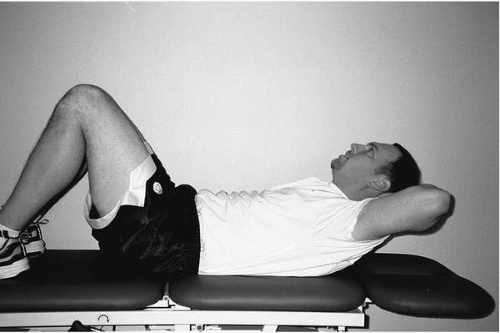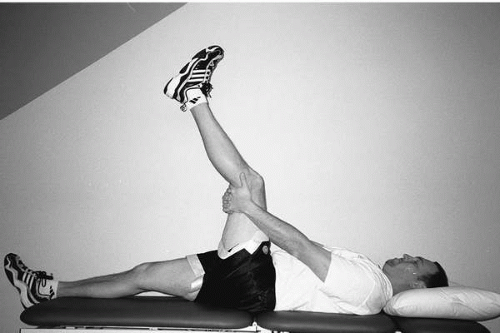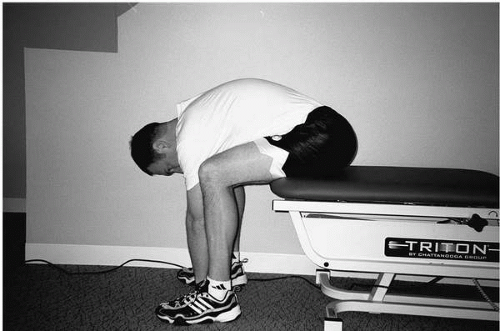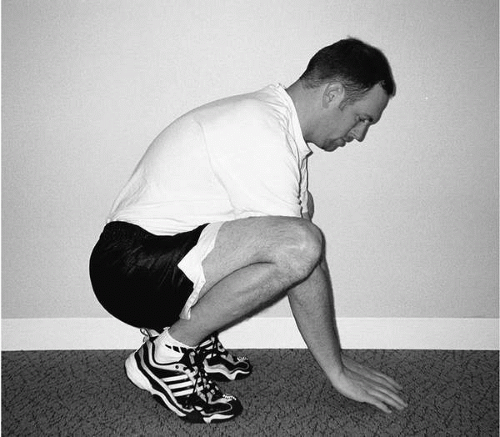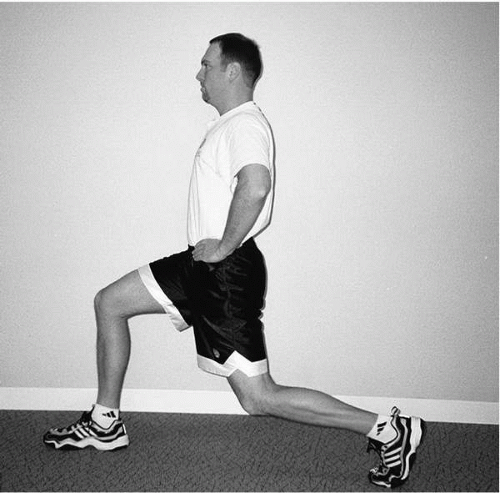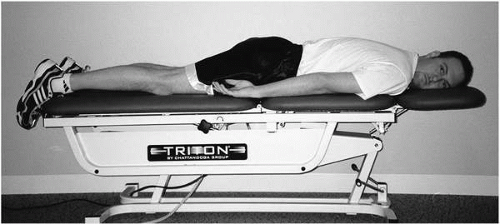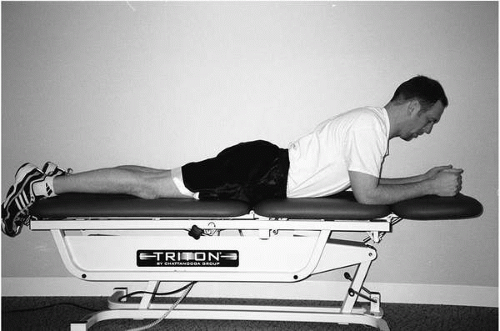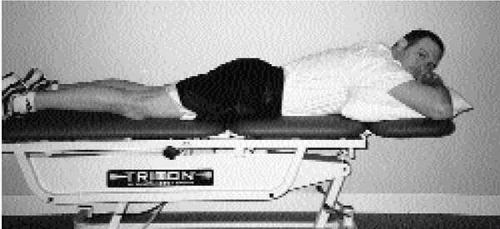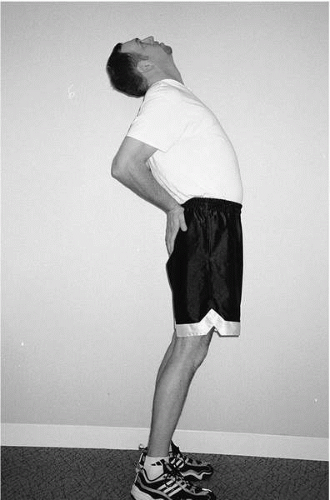Resistance Training and Core Strengthening
Donald A. Chu
Christine Boyd
Andrea Hammer
INTRODUCTION
Resistance training programs for the overhead athlete should focus on developing strength, power, and outcome gains, which directly contribute to improved function and performance. It is a well-established fact that throwing and overhead activities follow an activation sequence known as the kinetic chain. The kinetic chain is a summation of all the forces developed within the body, applied in the proper sequence, which results in the outcome of throwing or overhead striking a ball or object. The overhead action really begins from the ground up.
The sequence of activation in the kinetic chain works from proximal to distal in overhead activities. The goal is to impart maximum force or velocity through each part of the proximal kinetic chain so that the distal segments (shoulder, arm, and hand) ultimately reach their maximum velocity. This process may be viewed as “cracking the whip.”
Because the lower extremities are relatively large in terms of mass, they are responsible for most of the force developed in the kinetic chain. Hence, in activities such as baseball pitching, lower extremity force production (strength and power) is more highly correlated with ball velocity than is upper extremity force production. It follows that any program aimed at achieving an outcome of increased overhead velocity should first address the development of general, functional, and sport-specific strength in the lower extremities.
Kibler and colleagues describe the physiologic model for throwing and striking sports as a “motor” program (1). Motor programs activate muscles in a coordinated sequence of events that creates joint movements related to the movement task. The first event occurs at a single joint, which is stimulated by joint perturbations. These perturbations are resisted and force-couple activation among muscles occurs to stabilize the joint. Next, force-dependent patterns coordinate motions at several joints and use agonist-antagonist activation to generate forces that are directly applied to throwing or striking an object. In combination, these two activities result in task orientation for the muscle contractions and include lower extremity and trunk muscle activation before and during arm motion.
The core is what transmits the forces generated from ground reaction and the lower extremities to the distal upper extremity segments or an object. The core must be strong and stable in order to effectively transmit forces that have as the outcome a functional task. In addition to generating and transferring force to distal segments, these motor programs create a stable base from which voluntary arm movements occur. This allows for maintenance of body equilibrium during the course of throwing or overhead striking an object. Sensory and proprioceptive information for positioning and feedback during the activity are also required for integration and activation of the complete throwing motion.
Resistance training and core strengthening must start as general training programs and advance to programs specific to position, motion, and function. These should include gravity resistance and joint integration to stimulate the appropriate functional patterns. Given the importance of trunk musculature as a conduit for ground reaction forces through the kinetic chain, there are many questions that must be addressed:
Is the object of resistance training programs to develop maximal strength, strength-endurance, or actual power output?
What modalities are the most effective at achieving these goals?
What areas of the trunk should be addressed first and most frequently?
How many exercises should be included in a core-strengthening program?
What sorts of loads or intensities should be used with the exercises?
BACKGROUND
Historical
A significant portion of the functional outcome, strength, and power generated at the shoulder relies on contributions from more proximal body segments including the core. The term core strength traditionally encompasses the muscles of the torso that are involved in originating movement. These include the rectus abdominis, internal and external obliques, and erector spinae. Virtually all of the past and recent program developments in the area of core strengthening have been the result of attempting to reduce or mitigate low back pain. Even though the primary theme of this chapter is to address core-strengthening routines for overhead athletes who do not suffer from symptoms that limit range of motion or function, it would be a major oversight not to acknowledge those practitioners who helped define the field of core strengthening by treating low back pain. It is through their efforts that preventive programs have been developed and refined to avoid some of the long-term effects of degeneration while optimizing performance (2).
Among the first programs attempting to develop core strength were the “Williams Flexion Exercises” (3). These were among the primary modalities for the treatment of low back pain in the 1970s. The principal tenet of Paul Williams, MD, in 1937 was “Always sit, stand, walk, and lie in a way that reduces the lumbar lordosis to a minimum.” He believed that lumbar lordosis placed unacceptable pressure on the posterior aspect of the intervertebral disc, which, in turn, accelerated the degenerative process. Williams’ goal was to reduce lumbar lordosis as much as possible. Interestingly, he believed the same regarding the lordotic curve in the cervical spine.
The major thrust of his exercise routine consisted of a series of what Williams referred to as “first aid exercises.” These exercises are as follows:
Partial sit-up—The athlete lies in a “hooklying” position (supine with knees bent and feet flat). With hands behind his or her head, the athlete elevates the upper torso until the scapulae clear the resting surface and stress is placed on the rectus abdominis. After returning to the start position, the sit-up is repeated for a prescribed number of repetitions (Fig. 6-1).
Knee-to-chest—From the hooklying position, the athlete places his or her hands over his or her knees and pulls them slowly toward the chest. This movement flattens the lumbar spine, stretching the low back, including the posterior hip, sacroiliac joints, and high hamstring area.
Hamstring stretch—Lying supine, the athlete places both hands around the back of one knee. The athlete straightens his or her knee and pulls the thigh toward his or her head so the hip goes into flexion. Williams believed that flexible hamstrings are necessary to accomplish full flexion of the lumbar spine. Although tight hamstrings limit lumbar flexion in standing with knees straight, we now know that tight hamstrings actually tilt the pelvis posteriorly and promote trunk flexion (Fig. 6-2).
Seated flexion—This exercise is performed by sitting in a chair and flexing forward in a slumped position. Maximum trunk flexion is obtained and direct stretching of the lumbosacral soft tissue structures occurs (Fig. 6-3).
Squat—Williams’ squat position is with the feet placed shoulder width apart, the hips and knees are flexed to the maximum available range of motion, and the lumbar spine is rounded into flexion. Upon reaching maximum depth, the athlete “bounces the buttocks up and down” 15 to 20 times, with 2 to 3 inches of excursion on each bounce, then repeats three to four times. Williams believed that cultures that “hunkered down” in this position tended to have less back pain (Fig. 6-4).
Lunges—This exercise actually results in some extension of the lumbar spine when performed properly. Nonetheless, it is a good stretching exercise for the entire lower extremity, especially the iliopsoas, which may be a perpetrator
of low back pain if it is abnormally tight or in spasm (Fig. 6-5).
For years, the Williams Flexion Exercises were the mainstay of most low back pain prevention and care programs (4). They certainly accomplished the goal of flattening the lumbar spine and were advocated by physical therapists who worked with sports and industrial injuries. Although the success was limited, Williams’ comprehensive program helped advance the idea that strong abdominal muscles are needed to prevent low back pain and improve core strength.
Robin McKenzie, MD, in 1981 followed Williams in the development of an exercise program for controlling back pain (4). Although at first it seems contradictory to Williams’ program, they are similar in that both methods teach movement control techniques. Like Williams, McKenzie also claimed that the intervertebral disc is the major source of back pain. However, he differed from Williams in that he claimed “flexion” to be the culprit in developing low back pain. According to McKenzie, prolonged sitting in a flexed position and frequency of flexion were the primary reasons for disc degeneration, and the lack of lumbar extension was a predisposition to low back pain. His discovery that some low back pain patients had reduced symptoms with extension movements was counter to Williams’ line of thinking at that time.
The goal of McKenzie’s exercises was to “centralize” pain. For example, in a patient with lower back pain that radiated to the left buttock, left posterior thigh, and left calf, the goal was to have the pain move proximally so that it only radiated from the lower back to the posterior thigh. Then, the goal was to centralize the pain so that it only radiated to the buttock, and then finally have the pain localized in the low back. This was accomplished through a system that emphasized extension movements of the lumbar, thoracic, and cervical spines. McKenzie postulated that extension of the spine corrects posteriorly displaced intradiscal mass, which was presumed to be the embryonic stage of disc herniation. This dynamic disc model provided an explanation for the commonly noted phenomenon of “centralization” in which disc pain is abolished and symptoms move more proximally, often in response to spinal extension exercises.
There is an entire McKenzie certification process and credential available for physicians and physical therapist to study and undergo with regard to the McKenzie system of assessment and evaluation. The exercises presented here are a sample of the myriad of movements proposed by Dr. McKenzie and are presented in the context of those relating to “core strength.”
Prone lying—The athlete lies prone with arms along his or her sides and head turned to the most comfortable side. The athlete maintains this position for 5 to 10 minutes (Fig. 6-6).
Prone lying on elbows—The athlete lies prone with anterior hips touching the floor and his or her body weight on the elbows and forearms. With relaxation of the lower back muscles, the lumbar spine moves into extension. The athlete maintains this position for 5 to 10 minutes. If it causes pain, exercise 1 should be repeated and then this one tried again (Fig. 6-7).
Progressive extension with pillows—The athlete lies prone with a pillow under his or her chest. After 2 to 3 minutes, a second pillow is added. If this does not result in increased pain, a third pillow should be added. If possible, the athlete should stay in this position for up to 10 minutes. Pillows should be removed one at a time over several minutes (Fig. 6-8).
Prone press-ups—The athlete lies prone with palms near his or her shoulders, as if to do a standard push-up. While maintaining contact between hips and floor, the athlete slowly pushes up his or her shoulders and lets his or her back and stomach sag and move into extension. After reaching maximum extension range (before hips coming away from the resting surface), the athlete slowly returns to the start position by lowering his or her shoulders (Fig. 6-9).
Standing extension—While standing, the athlete places his or her hands on the small of his or her back with fingers pointing toward the floor and resting over the buttocks. The athlete then leans backward over his or her hands and holds the position for 20 seconds. This exercise should be repeated 10 times and should be performed throughout the day after normal activities that place the athlete’s back in a flexed position, that is, lifting, forward bending, sitting, and the like (Fig. 6-10).
Although both Williams’ and McKenzie’s systems may result in increases in trunk strength and range of motion, there is a fair share of controversy over their efficacy and effectiveness in treating low back pain (4). Looking at this issue from a historical perspective, they have both provided some benefits during the time of their peak popularity and both support the concept that “some movement is better than no movement.”
Current Concepts
More recent work by Hodges and co-workers (4) has focused on differentiating the local stabilizing system of musculature for the intervertebral joints and sacroiliac region from the global stabilizing system of the spine (Table 6-1).
The efforts of Hodges and co-workers (4) are the most recent attempts to define mechanisms to stabilize the spinal
segments for the purpose of reducing low back pain. They postulate that the global stabilizing system alone is unable to provide “core stability” and maintain an intersegmentally stable spine. Through their research, they have found that the transversus abdominis and multifidus are crucial in stabilizing the lumbar spine and lumbosacral regions, and poor function of these muscles has a direct effect on low back pain.
segments for the purpose of reducing low back pain. They postulate that the global stabilizing system alone is unable to provide “core stability” and maintain an intersegmentally stable spine. Through their research, they have found that the transversus abdominis and multifidus are crucial in stabilizing the lumbar spine and lumbosacral regions, and poor function of these muscles has a direct effect on low back pain.
Stay updated, free articles. Join our Telegram channel

Full access? Get Clinical Tree


